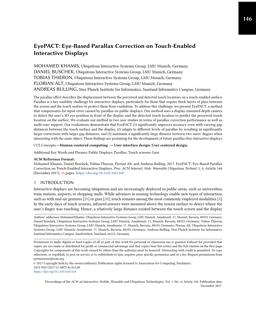The parallax effect describes the displacement between the perceived and detected touch locations on a touch-enabled surface. Parallax is a key usability challenge for interactive displays, particularly for those that require thick layers of glass between the screen and the touch surface to protect them from vandalism. To address this challenge, we present EyePACT, a method that compensates for input error caused by parallax on public displays. Our method uses a display-mounted depth camera to detect the user’s 3D eye position in front of the display and the detected touch location to predict the perceived touch location on the surface. We evaluate our method in two user studies in terms of parallax correction performance as well as multi-user support. Our evaluations demonstrate that EyePACT (1) significantly improves accuracy even with varying gap distances between the touch surface and the display, (2) adapts to different levels of parallax by resulting in significantly larger corrections with larger gap distances, and (3) maintains a significantly large distance between two users’ fingers when interacting with the same object. These findings are promising for the development of future parallax-free interactive displays.
Publication
 |
Mohamed Khamis, Daniel Buschek, Tobias Thieron, Florian Alt und Andreas Bulling. EyePACT: Eye-Based Parallax Correction on Touch-Enabled Interactive Displays. In Proc. ACM Interact. Mob. Wearable Ubiquitous Technol., 1, 2018, 146:1--146:18. [Download Bibtex] |